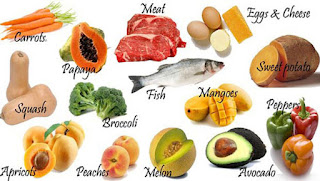Vitiligo is a disease that can be embarrassing and difficult to treat. Marked by a lack of pigment in patches of skin, it can affect any part of your body, but common sites include the face, hands, armpits, hair and around body openings. Your physician may recommend traditional therapies, although the National Vitiligo Foundation suggests that nutritional deficiencies may contribute to the condition. Work with your health care provider to incorporate vitiligo-fighting foods into your diet.
Vegetables and fruits on top
Antioxidants, phytochemicals, beta carotene in these bounties of nature support your immunity, promote healthy skin and may aid in the pigmentation process. Antioxidants and beta carotene neutralize free radicals and protect against their damage.
The major antioxidant nutrients are vitamins A, C, E, folic acid, polyphenolic flavonoids and some minerals like selenium, copper and zinc. Apples, bananas and citrus fruits are some great choices and must be included in your vitiligo diet. However, blueberries and pears should probably be limited or avoided as they contain natural hydroquinone, which are de-pigmenting agents.
Eating your vegetables lightly cooked and closer to raw is most preferable as it preserves their nutrients.
Never let your Vitamins go.
A couple of research studies across the globe have discovered that vitiligo patients may have vitamin deficiencies, especially of the B12 vitamin and folic acid.
You can replenish your body by eating vitamin-rich foods. Vitamin B12 is found in meat, poultry, eggs, soy milk, dairy products, fish, and shellfish. Folate, the natural form of folic acid, is found in fruits, dried beans and green vegetables. Ensure that you get enough vitamin D and C as they’re essential for healthy skin.
You can get vitamin D naturally from moderate sunlight exposure as directed by your doctor. Moreover, foods like oily fish, cod liver oil, liver, milk, eggs, cheese, margarine, some milk powders and yogurts and some cereals are fortified with it. Citrus fruits are your go-to option for ample vitamin C. Studies have shown that Folic acid and vitamin B12 work in conjunction with vitamin C to aid in the pigmentation process.
Must Minerals.
Copper, iron, zinc and calcium all play a role in the pigmentation process. Higher levels of zinc and copper have been shown to reduce premature greying hair. Low levels of both these minerals along with reduced iron levels have also been found in de-pigmented skin. Iron also has a role in the activation of tyrosinase which is an enzyme requiring copper and is essential in the pigmentation process. Zinc, an important mineral can be found in beef, shellfish, nuts, and legumes. Calcium, found in dairy products is another important nutrient for overall healthy functioning of your body which will ultimately impact your skin in a positive way.
What you can avoid.
Turmeric, used as a seasoning in Eastern foods especially, has been shown to cause problems for some people, so you might consider limiting or avoiding its use.

No comments:
Post a Comment